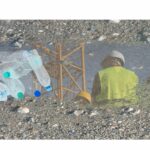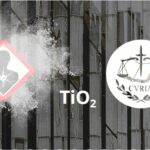
Life cycle of nanomaterials and nano-enhanced products

Consider the entire life cycle of nanomaterials and nano enhanced products
By the AVICENN team – Last updated May 2024
In order to not to repeat the mistakes of the past, it is necessary that industrialists, risk assessment and management authorities and researchers consider the entire life cycle of nanomaterials: from initial production, usage or consumption to destruction or recycling.
A comprehensive approach – social life cycle assessment (SLCA) – is being promoted by the United Nations Environment Programme (UNEP)1Guidelines for Social Life Cycle Assessment, UNEP, 2009. It can be applied to nanomaterials and must be conducted prospectively, prior to commercialization – not in “firefighting mode” after health or environmental problems have arisen. This is a broader “benefit-risk” analysis than that commonly proposed by proponents of the traditional (and limited) risk assessment approach. In particular, it considers the following questions: “what benefits/risks, for whom, where, when?
At present, scientists have very limited knowledge of the types of nanomaterials that are incorporated into products currently on the market, and a fortiori of any degradation residues of nanomaterials released throughout the “life cycle” of these products; they also know little about their mobility and transformations in the environment or in the human body: many parameters come into play, such as the ageing of the nanomaterials2See for example Ageing influences the toxicity of two innovative nanofertilizers to the soil invertebrates Enchytraeus crypticus and Folsomia candida, C. Maleihro, Environmental Pollution, 350, Juin 2024, the degree of acidity or salinity of the water for example3On the influence of acidity on the physicochemical parameters of nanomaterials, see for example:
– Fate of iron nanoparticles in the environment. Colloidal stability, chemical reactivity and impacts on plants Edwige Demangeat’s thesis, Geosciences Rennes UMR 6118, 2018
– Natural acids in soil could protect rice from toxic nanoparticles, Science News, April 2015.
In May 2019, Science for Environment Policy reports on the progress of a life cycle assessment method tailored to emerging technologies: the Lifecycle Screening of Emerging Technologies (LiSET). Will it be usable and used before the marketing of certain “nanos”? The question needs to be investigated.
In French :
- “Exposure to nanomaterials must be assessed throughout the life cycle to design safer products,” points out Jérôme Rose, CNRS Silver Medal 2020, Industry & Technologies, May 25, 2021
- Management of waste and effluents containing nanomaterials. Fate and impact in the treatment and recovery processes – Summary Ecogeos, RECORD, 2019
- 3rd regional NEC (“nano eco design”) working group on “Eco-design of nanomaterials”, organized by Labex Serenade and Éa éco-entreprises in Aix-en-Provence: Life Cycle Assessment – for a “safer by design” approach, February 2019
- Assessment of the risks associated with nanomaterials – Issues and update of knowledge, ANSES, April 2014
- The life of nanomaterials… and ours? Nanotechnology Citizen’s Collective of the Plateau de Saclay, April 2014
- Legal reflections on the life cycle assessment of nanomaterials, Techniques de l’ingénieur, April 2014
In English:
- Nanosafety Analysis of Graphene-Based Polyester Resin Composites on a Life Cycle Perspective, Aznar Mollá, F et al, Nanomaterials, 12, 2036, 2022
- Morphological transformation of silver nanoparticles from commercial products: modeling from product incorporation, weathering through use scenarios, and leaching into wastewater, Mohan S et al, Nanomaterials, 9(9), 1258, 2019
- Environmental Life Cycle Assessment of Nanosilver-Enabled Bandages, Pourzahedi L and Eckelman MJ, ES&T, March 2015
- Safety of Nanomaterials along Their Lifecycle: Release, Exposure, and Human Hazards
Wohlleben W et al, CRC Press, 2015 - Life Cycle Assessment of ‘Green’ Nanoparticle Synthesis Methods, Environmental Engineering Science, June 2014
- From Cradle-to-Grave at the Nanoscale: Gaps in U.S. Regulatory Oversight along the Nanomaterial Life Cycle, ES&T, May 2013
- LCA and Responsible Innovation of Nanotechnology, 2013
- NanoSustain Factsheet and Case Studies, 2013
- Analysis and strategic management of nanoproducts with regard to their sustainability potential Analysis and strategic management of nanoproducts with regard to their sustainability potential, Öko-Institut, July 2012
- Life cycle assessment of engineered nanomaterials, Science of The Total Environment, May 2012
Any questions or comments? This information sheet compiled by AVICENN is intended to be completed and updated. Please feel free to contribute.
Other news on the topic
Upcoming Nano Agenda
- Nobel Day conference for the general public
- Speaker: Sophie Carenco, CNRS Research Director at the Centre Interdisciplinaire de Nanoscience de Marseille CINAM, Aix Marseille University.
- Dates: December 4, 2025
- Organizers: CNRS
- Website: https://sciences.univ-amu.fr/fr/journee-nobel
- Annual conference of the NaMasTE research group (Manufactured Nanomaterials, Toxicology, Ecotoxicology and Risks: towards controlled development)
- Dates: December 9 and 10, 2025
- Organizers: CNRS
- Website: https://namaste2025.sciencesconf.org

- Webinar presenting the actions taken, projects completed, and future prospects during the last three years. This event will be an opportunity to share scientific advances, industrial collaborations, and initiatives designed to strengthen competitiveness and safety in the nanomaterials sector.
- Organizers: NanoMesureFrance
- Speakers: Valérie Godefert & François-Xavier Ouf (LNE & NanoMesureFrance)
- Website: www….nanomesurefrance-webinar-…
This sheet was originally created in November 2014
Notes and references
- 1
- 2See for example Ageing influences the toxicity of two innovative nanofertilizers to the soil invertebrates Enchytraeus crypticus and Folsomia candida, C. Maleihro, Environmental Pollution, 350, Juin 2024
- 3On the influence of acidity on the physicochemical parameters of nanomaterials, see for example:
– Fate of iron nanoparticles in the environment. Colloidal stability, chemical reactivity and impacts on plants Edwige Demangeat’s thesis, Geosciences Rennes UMR 6118, 2018
– Natural acids in soil could protect rice from toxic nanoparticles, Science News, April 2015



